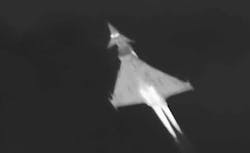Air Force considers developing advanced staring infrared search and track for combat aircraft
WRIGHT-PATTERSON AFB, Ohio, 23 July 2014. U.S. Air Force electro-optics researchers are reaching out to industry for ideas and enabling technologies for a next-generation infrared search-and-track (IRST) system to provide advanced passive surveillance, tracking, and target-acquisition capability for military combat aircraft.
Officials of the Air Force Research Laboratory at Wright-Patterson Air Force Base, Ohio, have issued a sources-sought notice (RFI-RQKS-2014-0001) for the Infrared Search and Track Technologies program, which seeks to determine the feasibility of developing a next-generation airborne long range offensive IRST.
Air Force researchers are interested in a new kind of IRST that is a staring sensor, rather than a scanned system, based on combinations of innovative optical design, high dynamic range infrared large format focal plane array (FPA) technology, and advanced processing methods.
Infrared search and track capability is important for modern aircraft because it can detect and track enemy aircraft and missiles without giving away its presence. Active search systems like radar, for example, must emit electronic signals that tip off the enemy to its presence; it's like shining a flashlight in a darkened room.
Related: Boeing to install infrared search and track systems on Navy carrier-based jet fighters
This exploratory concept is fundamentally different from current IRST implementations that use scanned and smaller-format infrared focal plane arrays for detection and tracking of enemy aircraft and missiles, researchers explain.
An IRST with a staring rather than a scanning sensor will yield higher performance in a more compact, lighter-weight design with greater installation flexibility, Air Force researchers say.
Advancements in large-format two-dimensional infrared focal plane arrays offer potential advantages in clutter rejection, more frequent updates, longer integration times, and multi-frame detection techniques.
These advantages could yield an advanced IRST for military combat aircraft that supports long-range detection and tracking of targets in cluttered environments with a low false alarm rate over a large field-of-view (FOV), researchers say.
Related: Army eyes mast-mounted infrared sensors able to detect and track humans and aerial drones
U.S. aircraft have had infrared search and track systems since the now-retired Navy F-14 Tomcat carrier-based jet fighters of the 1970s. Today the Lockheed Martin Corp. Missiles and Fire Control segment in Orlando, Fla., builds the IRST21 Sensor System, an IRST that can be installed on the F-16 fighter, F/A-18E/F fighter-bomber, and F-15C jet fighter.
The Lockheed Martin F-35 joint strike fighter has the Northrop Grumman AN/AAQ-37 Distributed Aperture System (DAS), which provides the aircraft with 360-degree IRST capability, missile detection and tracking, launch point detection, weapons support, and navigation in daylight and at night.
The Air Force would like to hear from companies that could provide advanced IRST enabling technologies as part of assessment of industry's ability to provide component and system-level technologies for a next-generation airborne IRST.
Key considerations include wave-band selection; single-band longwave vs. medium-wave infrared sensors; dual-band longwave and medium-wave infrared sensors; sensitivity; dynamic range; frame rate; integration time; resolution; operability; readout design trades; wide-field optical design for large format arrays; opto-mechanical design; stabilization; real-time algorithms and processing; processing techniques; clutter rejection methods; target detection and track algorithms; clear sky; sky clutter; and look down into heavy clutter.
From industry, Air Force researchers would like information about component technical maturity and availability, as well as system implementation considerations. This RFI is for planning purposes only.
Companies interested should email white papers no later than 15 Aug. 2014 to the Air Force's Robert Feldmann at [email protected] and Jo Ann Sillaman at [email protected].
Email technical questions to Robert Feldmann at [email protected], and email contracting questions to Jo Ann Sillaman at [email protected].
More information is online at https://www.fbo.gov/spg/USAF/AFMC/AFRLWRS/RFI-RQKS-2014-0001/listing.html.

John Keller | Editor
John Keller is editor-in-chief of Military & Aerospace Electronics magazine, which provides extensive coverage and analysis of enabling electronic and optoelectronic technologies in military, space, and commercial aviation applications. A member of the Military & Aerospace Electronics staff since the magazine's founding in 1989, Mr. Keller took over as chief editor in 1995.

